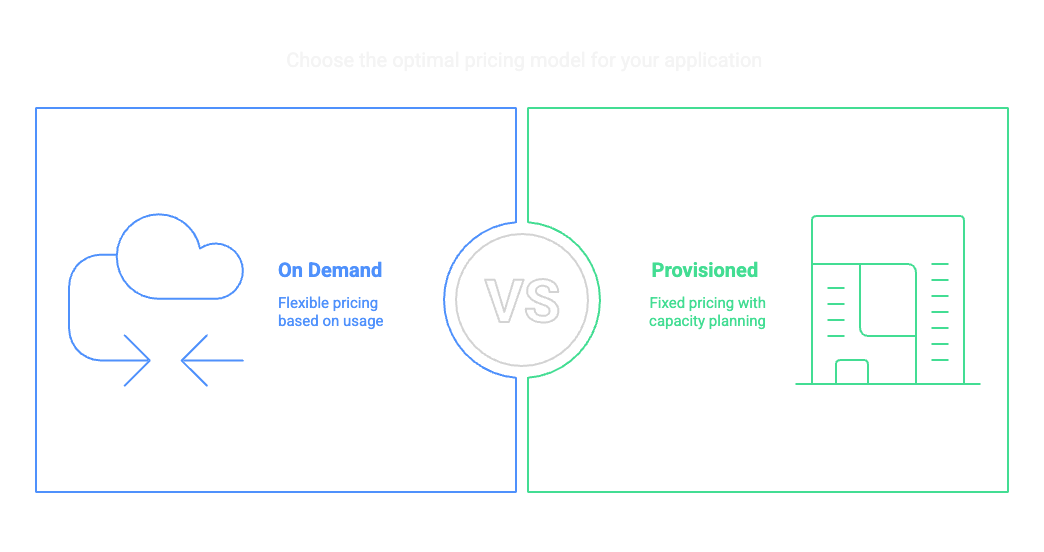Pricing Models¶


We’ve put together an overview of each DynamoDB pricing [1] model to help you understand the differences and choose the one that’s right for you. We also show you how these models compare to each other and the savings you can achieve by switching to ScyllaDB.
DynamoDB Pricing Model Overview¶
DynamoDB offers two distinct pricing models: On Demand [2] and Provisioned [3]. Provisioned has an additional option called Reserved Capacity. Each model has its own pricing structure and is designed to meet different needs. The pricing model you choose will depend on your application’s requirements and usage patterns.
On Demand¶
On Demand pricing is a pay-as-you-go model that charges you based on the number of read and write requests your application makes. This model is suited for applications with variable workloads or for those just starting out. However, there is a premium for this flexibility, and costs can quickly add up if your application has unpredictable or high-volume traffic.
Provisioned¶
Provisioned pricing allows you to specify the read and writes per second that you expect your table to use. You pay a fixed rate for any capacity you reserve, regardless of how much you use. This model is ideal for applications with predictable workloads, as it can help you save money by reserving capacity in advance. However, if you exceed your capacity, your requests will be throttled, which will negatively impact your application’s performance.
Provisioned + Reserved Capacity¶
Reserved Capacity pricing allows you to reserve read and write capacity for your tables for a fixed term. You pay an upfront fee for the capacity you reserve, and receive a discount on the provisioned rate. This model is ideal for applications with steady workloads, as it can help you save money in the long run. However, you will be charged for the reserved capacity even if you don’t use it.
How these Models Compare to Themselves¶
When comparing the pricing models, it’s important to consider your application’s requirements and usage patterns. If you have relatively low volume workloads, On Demand pricing may still be the best option for you. If you have a relatively static workload, Provisioned pricing may be the best option for you.
Relative cost can vary significantly depending on your application’s usage patterns. In general, On Demand pricing is the most expensive option, while Provisioned with Reserved Capacity pricing is the cheapest option. Provisioned pricing falls in between the two.
What you need to know is that the On Demand pricing model is the most expensive option. You will be paying up to +700% premium for the flexibility of not having to provision capacity.
Provisioned with Reserved Capacity pricing is the cheapest option, but it requires you to pay for the reserved capacity, even if you don’t use it.
Take a look at the tables below for a quick comparison of the three pricing models.
Write Heavy Workloads¶
Write heavy workloads are those that have a high number of write requests compared to read requests. These workloads are typically characterized by a high volume of data being written to the database, such as real time events, logs, or telemetry data.
On Demand |
Provisioned |
Reserved |
|---|---|---|
$10M per year most expensive |
$2.9M per year 3x cheaper |
$1.3M per year 7x cheaper |
On Demand |
Provisioned |
Reserved |
|---|---|---|
$11.3M per year most expensive |
$3.3M per year 3x cheaper |
$1.7M per year 7x cheaper |
Read Heavy Workloads¶
Read heavy workloads are those that have a high number of read requests compared to write requests. These workloads are typically characterized by a high volume of data being read from the database, such as near real time events, caching, or reporting data.
On Demand |
Provisioned |
Reserved |
|---|---|---|
$2.9M per year most expensive |
$855k per year 3x cheaper |
$392k per year 7x cheaper |
On Demand |
Provisioned |
Reserved |
|---|---|---|
$3.2M per year most expensive |
$926k per year 3x cheaper |
$463k per year 7x cheaper |
Note
The above scenarios are based on the following assumptions:
512 GB of data stored in DynamoDB
1 KB item size
Standard table class
3 hours of peak traffic per day (for the peak hour scenarios)
100% read consistency
Upfront payment for reserved capacity included in monthly estimates
How these Models Compare to ScyllaDB¶
ScyllaDB offers a different pricing model than DynamoDB. ScyllaDB charges based on the number of cores/storage you use, rather than the number of read and write requests. This makes it much more cost-effective for applications with high-volume traffic, as you don’t have to worry about exceeding your provisioned capacity and being throttled.
In fact, we're so confident in our pricing model that we guarantee 50% off your existing DynamoDB workload costs.
When comparing DynamoDB and ScyllaDB, it’s important to consider your application’s requirements and usage patterns. If you have relatively low volume workloads, DynamoDB’s On Demand pricing may still be the best option for you. If you have a relatively static workload, DynamoDB’s Provisioned with Reserved Capacity pricing may be the best option for you.
However, ScyllaDB’s pricing model will be more cost-effective if you want to avoid throttling with real-life workloads driven by systems and users that perhaps follow daily or seasonal patterns…or bursty, large batch workloads with spikes…or any high-volume traffic in general. Many of ScyllaDB’s customers have reported significant cost savings after switching from DynamoDB for these reasons:
No need to worry about exceeding provisioned capacity and being throttled
No need to pay for unused capacity
No need to worry about unpredictable traffic spikes
No need to worry about the cost of read and write requests
References
